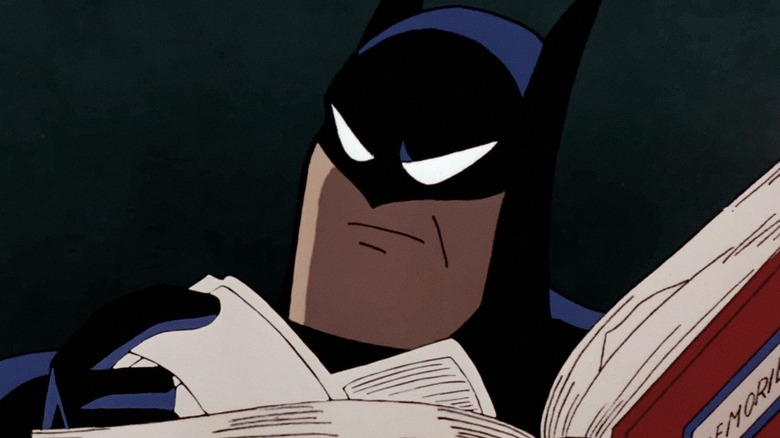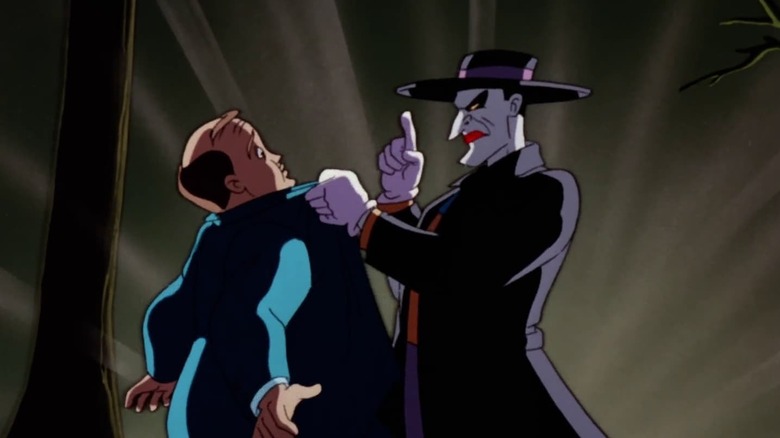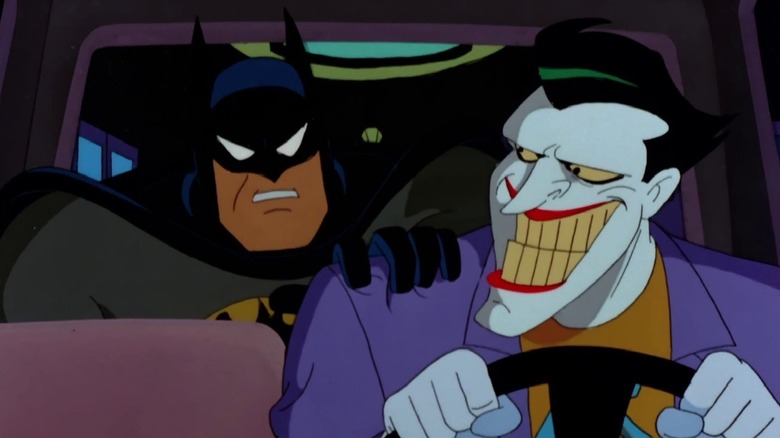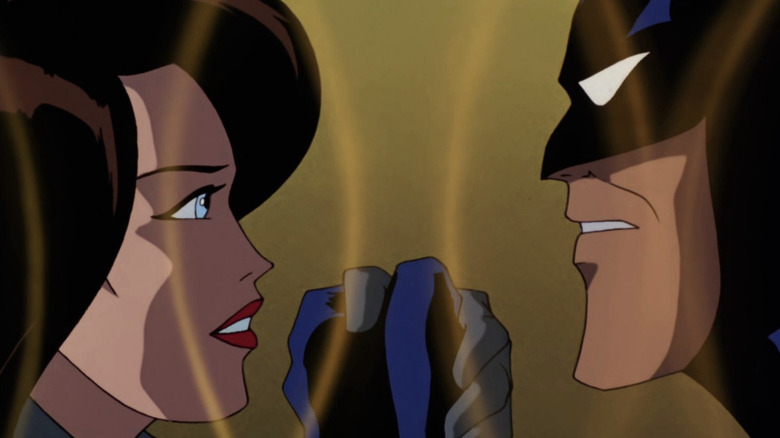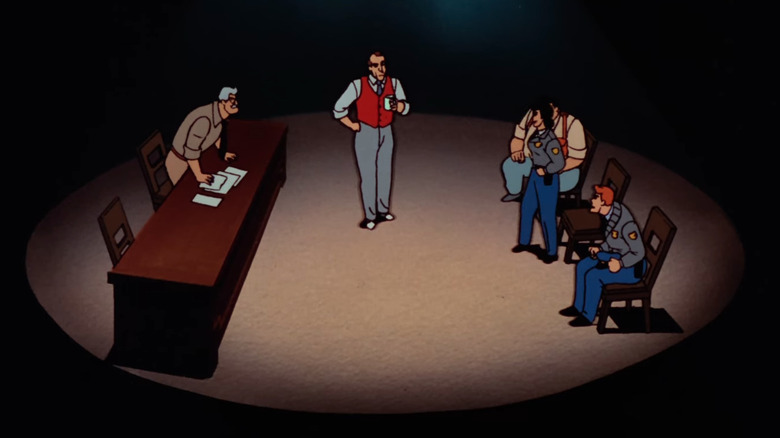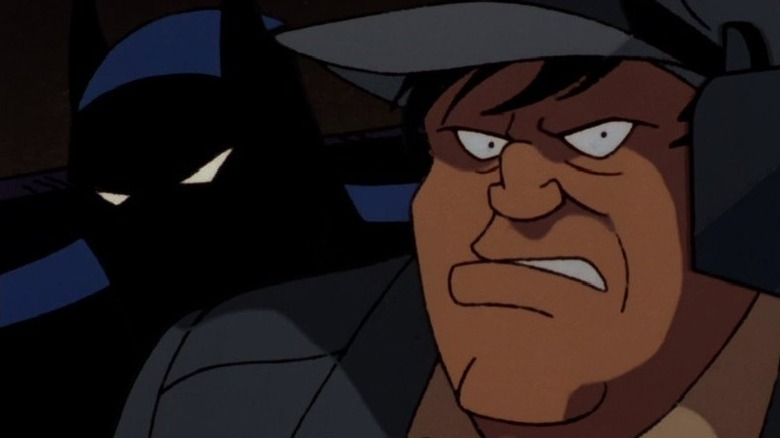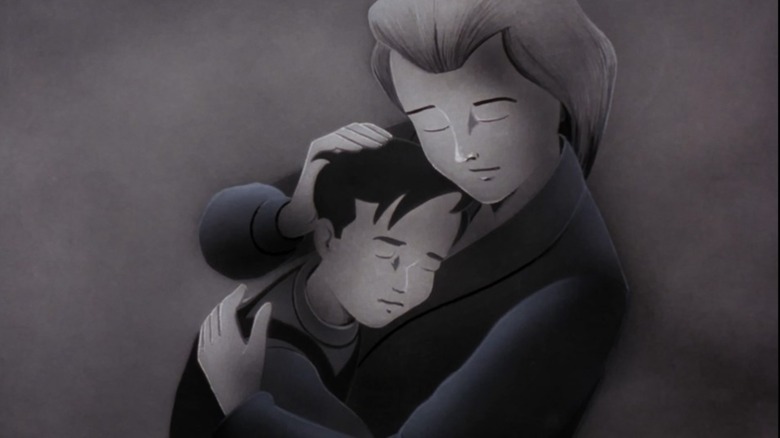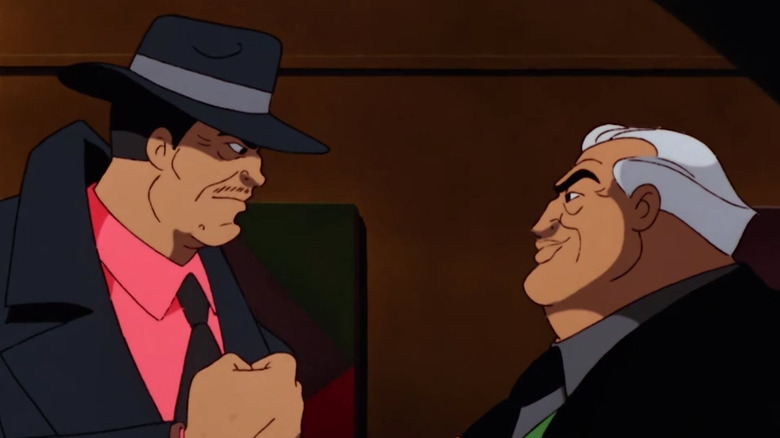The 7 Most Film Noir Episodes Of Batman: The Animated Series, Ranked
"Batman: The Animated Series" has many artistic fathers. Tim Burton's 1989 "Batman" film, of course, but also the Fleischer Studios Superman cartoons of the 1940s, the Art Deco movement (which the skyscrapers of Gotham City are made in the visage of), and film noir.
Noir is a film genre characterized by dark high-contrast shadows ("noir" means "black" in French) shot in black-and-white, featuring urban settings, crime (whether the lead is on the wrong or right side of the law), beautiful but duplicitous women, and nefarious schemes gone awry. Noir sprouted up in the 1930s-40s, when most films were black-and-white and pulp novels, from thrillers and to detective stories, were easy fodder for Hollywood adaptations. The storytelling motifs of those books were thus intertwined with Hollywood's biting black-and-white style.
"Batman: The Animated Series" was made in color (the villains have costumes running the whole rainbow spectrum), but it was drawn on black paper to create a darker mood than contemporary cartoons. The opening title sequence used heavy shadows, making Batman and the criminals he spars with look like silhouettes dancing in the night. Since "Batman" was at the end of the day a kids' show, there are some goofy episodes (see "Time Out of Joint," where Batman and Robin run as fast as the Flash thanks to time slowing down).
When the show got dark, though, its storytelling felt right out of a great noir.
7. Joker's Favor
Many film noir stories feature an everyman protagonist who gets swept up in a whirlwind simply by being in the wrong place at the wrong time. Take "Detour," where a cross-country driver winds up framing himself for murder, or Hitchcock pictures like "The Wrong Man" (where a man is mistaken for a similar-looking robber and prosecuted as such) or "North by Northwest" (Cary Grant plays a Madison Avenue ad man mistaken for a spy by Russian agents).
"Joker's Favor" follows a similar formula and shows just how terrifying the Joker would be without Batman to back you up. After a lousy day, average Joe Charlie Collins (guest star Ed Begley Jr.) gets cut off in traffic and curses out the guy who did it. Only problem? The other driver was the Joker. Charlie's only spared because he promised the Joker he would do him a favor one day — and in the episode's second act, the Clown comes calling.
"Joker's Favor" has been compared to a Hitchcock film and Charlie Collins is a lead worthy of one. This episode also marked the debut of Harley Quinn, but the soul of the story is Charlie.
6. Joker's Wild
This one's a favorite of mine. "Joker's Wild" is of course titled for the poker play where a Joker card can be any card the player wants. The reference to gambling isn't an incidental pun. In "Joker's Wild," Gotham City casino magnate Cameron Kaiser unveils his latest project: Joker's Wild, a casino modeled on the Joker. The Clown Prince of Crime doesn't take it as a compliment and decides to destroy the casino for "cashing in on his image."
Unbeknownst to the Joker, that's just what Kaiser wants, since the only way he can recoup his debts is an insurance payout on the casino. This scheme is right out of a noir picture; lots of such movies feature carefully laid murder plots that go off the rails. Insurance fraud is a common enough motive too — just think "Double Indemnity," the 1944 Billy Wilder Noir classic inspired by James M. Cain's novel and a real-life murder. Just like in that film, justice is delivered, but in this episode, it comes wearing a cape and a cowl.
5. Off-Balance
A noir doesn't need to have a femme fatale, but it helps. From "The Postman Always Rings Twice" up to "Basic Instinct," Hollywood thrillers are filled with wily, beautiful-and-know-it women who've been the death of lustful suckers.
"Off-Balance" features Batman meeting one such figure, Talia al Ghul, adapting their very first meeting in "Detective Comics" issue #411 (by Dennis O'Neil and Neal Adams). Like many femme fatale forebears, Talia is initially working alongside our hero but she backstabs him in the end.
Their common foe is another noir homage: they face the villainous Vertigo. Though adapted from the DC Comics villain Count Vertigo, the choice to use Vertigo (rather than the villain of the comic, Ebeneezer Darrk) suggests an homage to Alfred Hitchcock. The climax of "Off-Balance" even unfolds in a church tower, just like Hitchcock's "Vertigo" — all that's missing is the signature dolly zoom.
4. P.O.V.
The inspiration for "P.O.V." isn't a Hollywood classic, but Akira Kurosawa's "Rashomon" — a trial drama set in feudal Japan where three people offer three mutually contradictory accounts of a crime (glimpsed via flashback, so each "truth" in "Rashomon" feels equally real to the audience).
"P.O.V." moves the setting to Gotham City, where three police officers — Harvey Bullock, Renee Montoya, and Officer Wilkes — are questioned by Commissioner Gordon and Internal Affairs about a bust gone wrong. Unlike "Rashomon," the visuals of each flashback basically align, it's the narration that differs (highlighting how each one's perspective, or point of view, differs from what really transpired).
This is an episode premise that could easily fit in a mundane police show, and indeed, most of the episode's focus is on the cops and robbers. Even in the third act, when a now-suspended Montoya teams up with Batman to nail their man, the Dark Knight is seen mostly at a distance and has little dialogue.
3. A Bullet for Bullock
"Film noir" has connotations of "mystery movies." A common noir protagonist is a private investigator, after all, usually investigating someone's disappearance or murder (think "Chinatown" for an in-color noir of this sort).
"A Bullet for Bullock" is one such mystery story (the episode is adapted verbatim from "Detective Comics" #651 by Chuck Dixon and Graham Nolan). Like "P.O.V." this episode focuses less on Batman and more on the Gotham police — specifically, ill-mannered and sloven (but honest) detective Harvey Bullock. Someone is trying to whack Bullock and, since he's got a lot of enemies, he can't narrow it down. So, he turns to the World's Greatest Detective for help in finding the would-be assassin.
Batman famously has a lot of great bad guys, leaving Batman adaptations spoiled for choice in which villains they use, but "Batman: The Animated Series" showed how Gotham City is atmospheric enough to sustain stories without any killer clowns or sinister scarecrows. "A Bullet for Bullock" included.
2. Appointment in Crime Alley
Everyone under the sun knows Batman's origin story. "Batman: The Animated Series" never explicitly showed young Bruce Wayne's parents being killed (nor did it need to), but it would've been a challenge to make a Batman series and never discuss the shadow of tragedy cast over the hero's life. Indeed, one of actor Kevin Conroy's greatest moments playing Batman was when Bruce spoke before his parents' grave in the film "Mask of the Phantasm," which was spun off of "The Animated Series."
In the series itself, the episode that deals most with Bruce's backstory is "Appointment in Crime Alley." Batman visits the neighborhood where his parents died on the anniversary of the murder (the final shot of the episode is him placing two roses in the alley). All is not well in Crime Alley, though, because crooked businessman Roland Daggett is planning to firebomb the neighborhood — driving out the current inhabitants so he can redevelop it for pennies on the dollar.
Themes of urban decay are common in noir (see Jules Dassin's 1948 procedural "The Naked City," shot on sight in New York City instead of Hollywood sound stages). The lack of any colorful supervillains in this episode — instead, just a typical rotten landlord like Daggett — makes Crime Alley feel more like a neighborhood with real problems.
1. It's Never Too Late
"Angels With Dirty Faces" is a 1938 gangster picture, starring James Cagney as Rocky Sullivan, a delinquent turned gangster, and Pat O'Brien as Father Jerry Connolly, his childhood friend who became a priest instead of a criminal (but if Rocky had been the one who ran faster from the police, their fates could've easily swapped).
"Batman: The Animated Series" homages "Angels With Dirty Faces" in "It's Never Too Late," one of the series' most mature episodes which also features a gangster and a priest. The focus of the episode is aging Gotham City crime boss Arnold Stromwell, who's realizing that the criminal life he's built hasn't been worth it. He's surrounded by rivals who want him dead and he's estranged from his family (as Batman shows him, his missing son has become an addict, a casualty of Stromwell's own drug racketeering).
The episode features sepia-colored flashbacks depicting a young Stromwell and his brother Michael, who lost his leg saving Arnold from an onrushing train. In the present, a guilty Arnold keeps his distance from Michael, now a priest, but the younger Stromwell saves his brother's soul (after some pushing from Batman too). The episode's title is only a fraction of the episode's message — it's never too late to change — and the result is a happier ending than most noir pictures (but an earned one, not a forced Hays Code happy ending).
